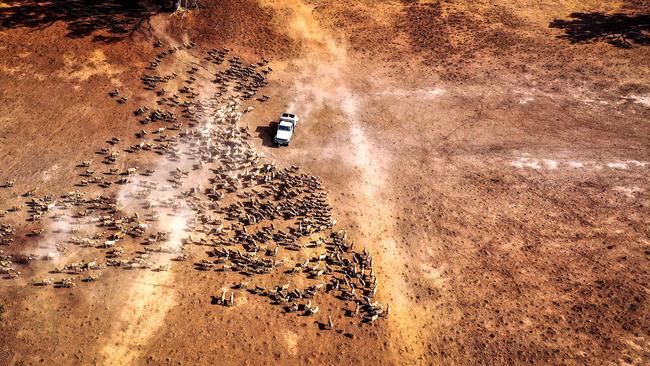Drought-ravaged profits
Throwing money at struggling farmers may not be the best way of dealing with this disaster.

“City people, politicians, have no concept of how difficult farming has become, how much cash businesses are burning through,” says Dugald Bucknell, whose family have farmed cattle at Quambone, 600km northwest of Sydney, since 1912. “The number of cows that have been slaughtered from this is phenomenal.”
The drought, which intensified in the middle of last year, has savaged farm profits — down by about a quarter. Output has fallen by 8 per cent, with a further 5 per cent expected this financial year, according to the latest forecasts by the Australian Bureau of Agricultural and Resource Economics and Sciences.
“The dry conditions have led to very low levels of stored water and soil moisture, which have reduced farm output and increased input costs,” the Reserve Bank said last Friday in its quarterly update. In the past 12 months, the nation has endured the second lowest rainfall since records began in 1901.
A weathered economy
If city people misunderstand farmers’ plight, they have less understanding of how drought affects the broader economy.
Weather patterns are such a big influence on the economy that one of the Reserve Bank’s models includes the Southern Oscillation Index, which gauges the strength of El Nino and La Nina.
Australia no longer rides on the sheep’s back — wool production has fallen steadily in recent decades — but agriculture contributes about 15 per cent of exports.
“The smaller national herd and flock size is likely to weigh on rural exports for some time until producers are able to rebuild livestock numbers,” the Reserve Bank said last Friday.
Farming is a small but volatile part of the economy, employing about 2.5 per cent of the workforce and contributing less than 3 per cent of gross domestic product. The sector enjoyed record-high incomes in 2016-17 and still were stellar in 2017-18, but results were abysmal in 2018-19 and likely to remain so this financial year.
In previous droughts, the textbook “supply shock” — where output contracts, causing prices to rise — had cut a full percentage point from GDP growth. This drought will shave 0.2 percentage points from GDP growth next year, JPMorgan economist Tom Kennedy says. That’s sizeable given the economy grew only 1.4 per cent across the year to June.
Food price spike
Consumers feel the effects of the drought in supermarkets, where prices for lamb, beef and dairy, and cereals have soared by 14 per cent, 7 per cent and 6 per cent during the past 12 months.
The cumulative impact of the drought on the consumer price index is probably more than 0.4 per cent, according JPMorgan research. Again, sizeable given inflation is well below 2 per cent.
The fatal fires raging in drought-stricken eastern Australia also have hit the economy. According to Geoscience Australia, bushfires have cost the economy about $4.7bn, in 2013 dollars, across the years 1967 to 2013. They’ve killed more than 430 people and injured 8000, contributing about half of all deaths from Australian natural disasters.
“People tend to forget how big previous droughts have been,” says Brian Fisher, noting farming output fell about 18 per cent in the severe droughts of the early 1980s and 2000s. Fisher, a well-known agricultural economist who has a farm in the NSW southern tablelands just outside the ACT, has been handfeeding his livestock for 12 months. “It’s the geographic extent of this one that makes it unusual,” he says.
When a flood can’t help
Farmers in Western Australia and Victoria, by and large, are doing well. In northern NSW and southern Queensland, however, rainfall has been the lowest ever, devastating towns where up to 20 per cent of employment relates to farming.
“Even the monstrous flood in the middle of 2016 didn’t help, we went back to drought the next week, with crusted ground. This drought has been smashing us for ages. Instead of 8000 steer, we did 3000 this year,” Bucknell says.
ABARES director Peter Gooday says the price of hay and fodder has doubled. “You can buy in grain to make up for the rain, but because the drought has been going for so long there’s basically no feed left,” he says.
Last week the federal government announced $7bn in support, including a new concessional loan scheme, for farmers and other affected businesses. The Nationals want a further $1.3bn drought-relief plan, which would be one of the largest.
Help is welcome and popular, but more than earlier generations of farmers received. “It’s social media,” Fisher says, explaining the political imperative to help farmers. “Boy, if we had social media in the ’57 drought or earlier parts of later on in 60s when I was growing up on the north coast of NSW on a dairy farm and we had dairy cows literally dying in the paddock.”
Cash handouts
Governments long have provided special assistance for farmers through direct cash payments and subsidies. This makes sense so farmers can avoid having to sell their properties in a fire sale, when asset prices are depressed. Farmers with land worth up to $5m can access government support programs, compared with a cap of $475,000 for the standard government unemployment benefit.
“The public rightly expects that farmers, like any business, are capable of handling the normal range of things that happen,” says Bucknell. “If someone’s preparing for Noah to sail past, that’s madness, just as it is to prepare for a drought of record and then some.”
Until the 90s, state governments helped pay for fodder and freight for farmers. Before the latest rounds of support the federal government, via the Regional Investment Corporation, let farmers borrow up to $2m at 3.11 per cent for business development. States still have subsidy programs, including $50,000 interest-free loans in NSW for small-scale infrastructure.
The government has increased the Farm Household Allowance, a longstanding social security-style payment set at the rate of Newstart and paid for up to four years. In September it made FHA available for longer and provided lump-sum payments of $7200 for single farmers and $12,000 for couples.
“The real struggle is how do you distinguish between what’s a reasonable thing to do from a welfare point of view, helping people who no longer have enough cashflow to put food on the table and send their kids to school, without getting in the road of structural adjustment,” says Gooday.
Bigger properties
The number of farms in Australia has halved since the mid-70s to about 90,000, as properties became larger and more efficient.
The process is likely to continue. About 80 per cent of farming output comes from 20 per cent of farmers, experts say.
Small farms remain numerous. Those with sales under $500,000 make up two-thirds of farms by number and about one-fifth of the total value of sales — almost all are family owned and operated.
The risk of federal assistance is it delays a more painful structure adjustment and puts off the consolidation of farms — costing taxpayers a small fortune on the way.
Former Nationals leader Barnaby Joyce has suggested some farmers should move on.
“We’ve got to support you in the drought, but if your place is just not viable, $36,000 just isn’t going to make a difference and people have to answer their own question in their own mind if this is the job in their life for them,” he told Sky News.
“We don’t want to keep people in potential poverty. People who have not made a profit in the last 10 years really need to seriously think, what are you doing with your life? What are you doing on the land?”
Not all farmers are doing badly. “Land values have gone up even though there’s a drought, wool prices are up, grain prices have been pretty good, and the price of hamburger meat has gone up massively,” Bucknell says, pointing to China, which consumes about one-fifth of the world’s protein, as the cause.
The value of farm management deposits, a tax-deferral vehicle where farmers can stash up to $800,000 of profits, has steadily increased.
During the past five years the number of accounts has increased 14 per cent to 48,000, while the value of funds in them has jumped 58 per cent to $5.7bn.
Nevertheless, their value fell sharply across the three months to September, down by $1bn, a sign many were doing it tough.
“My guess it’s the top 20 per cent who use these accounts,” says Fisher.
Commonwealth Bank, Australia’s biggest company, is a major lender to farmers.
Grain-growing regions across Australia face falls in productivity of up to 50 per cent, CommBank has said recently, because of changes in rainfall patterns expected by 2060.
Global warming
Climate change could change the economics of farming irrevocably.
“There’s no doubt climate change is happening. You’d have to be a fool to say the brainiest people in the world are wrong,” says Bucknell.
A CSIRO report recently concluded Australia’s climate had warmed by 1C since 1910, “leading to an increase in the frequency of extreme events”. The UN climate panel expects another 0.5C increase within the next 10 to 30 years.
Costs already are increasing for producers; insurers have permanently jacked up premiums to insure against hurricanes and tropical cyclones in the US.
More severe droughts will undermine a pillar of the Australian economy.
A supply shock will become a supply scar, crimping one of our most successful exports. The share of population living in the regions will shrink further.
Dorothea Mackellar might have loved them a century ago, but for the nation’s farmers droughts are an economic and social disaster whose effects reverberate throughout the economy.




To join the conversation, please log in. Don't have an account? Register
Join the conversation, you are commenting as Logout